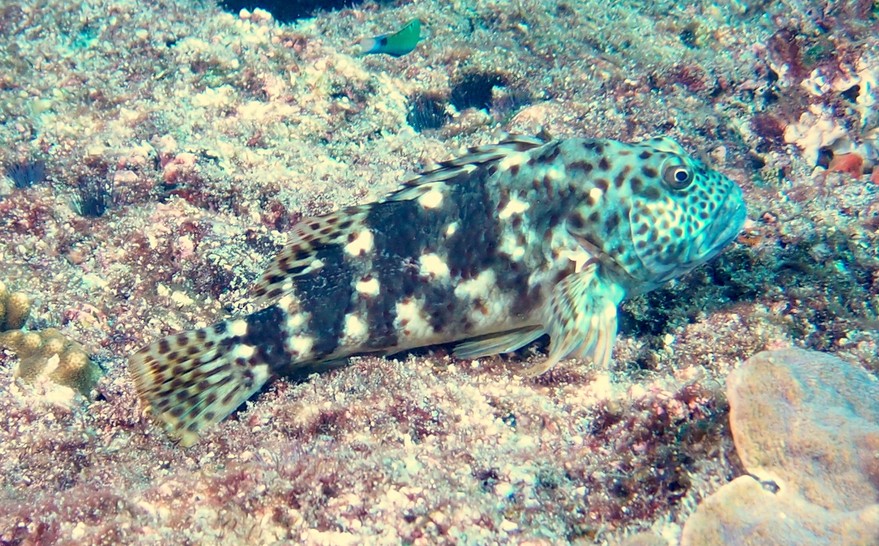CIRRHITUS SPILOTOCEPS - (SCHULTZ, 1950)
Actinopterygii (Gigaclass) > Actinopteri (Class) > Teleostei (Subclass) > Centrarchiformes (Order) > Cirrhitioidei (Suborder) > Cirrhitidae (Family) > Cirrhitus (Genus)
Diagnosis
Dorsal rays X,10 or 11; anal rays III,6; pectoral rays 14, the lower 7 unbranched and thickened; lateral-line scales 41–43 (usually 42); gill rakers 6–7 + 12–13 (rarely 12), total 16–20; body robust, the depth about 2.7–3.0 in standard length; snout short and blunt; 4 rows of large scales above lateral line in middle of body; 12 or more irregular rows of small scales on cheek; posterior margin of preopercle finely serrate; palatine teeth present; membranes of spinous portion of dorsal fin incised; a tuft of cirri from membrane near tip of each dorsal spine; pectoral fins short, not reaching a vertical at tips of pelvic rays when posterior in position; caudal fin slightly rounded; body dark olive green the scales nearly covered by a dark brown to black spot, grading to white ventrally, with three to four longitudinal rows of irregular white spots, some approximately square, and many dark brown spots of about pupil size; dark brown to black spots on head progressively smaller and more close-set anteriorly; spinous portion of dorsal with large dark brown spots, mainly on membranes; remaining fins with dark spots on rays. Reaches at least 22 cm total length.
Distribution
Red Sea, northwestern Indian Ocean: Socotra, Gulf of Oman.
Similar species
Cirrhitus pinnulatus (Forster, 1801) - Reported from Indo-West Pacific: East Africa, Madagascar and Mascarenes east to Hawaiian Islands and Pitcairn Group, north to southern Japan, south to Kermadec Islands and Rapa.
Diagnosis
Dorsal rays X,10 or 11; anal rays III,6; pectoral rays 14, the lower 7 unbranched and thickened; lateral-line scales 41–43 (usually 42); gill rakers 6–7 + 12–13 (rarely 12), total 16–20; body robust, the depth about 2.7–3.0 in standard length; snout short and blunt; 4 rows of large scales above lateral line in middle of body; 12 or more irregular rows of small scales on cheek; posterior margin of preopercle finely serrate; palatine teeth present; membranes of spinous portion of dorsal fin incised; a tuft of cirri from membrane near tip of each dorsal spine; pectoral fins short, not reaching a vertical at tips of pelvic rays when posterior in position; caudal fin slightly rounded; body dark olive green the scales nearly covered by a dark brown to black spot, grading to white ventrally, with three to four longitudinal rows of irregular white spots, some approximately square, and many dark brown spots of about pupil size; dark brown to black spots on head progressively smaller and more close-set anteriorly; spinous portion of dorsal with large dark brown spots, mainly on membranes; remaining fins with dark spots on rays. Reaches at least 22 cm total length.
Distribution
Red Sea, northwestern Indian Ocean: Socotra, Gulf of Oman.
Similar species
Cirrhitus pinnulatus (Forster, 1801) - Reported from Indo-West Pacific: East Africa, Madagascar and Mascarenes east to Hawaiian Islands and Pitcairn Group, north to southern Japan, south to Kermadec Islands and Rapa.
